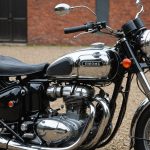Recognizing Clutch Plate Wear Symptoms
When it comes to the Hayabusa clutch, identifying clutch plate wear is crucial for maintaining your bike’s performance. Common symptoms of clutch wear can substantially impact riding experience. These signs should be acknowledged and addressed promptly to prevent further complications.
Symptoms of clutch wear often include a spongy or soft clutch lever feel, causing difficulty in shifting gears smoothly. You might notice a burning smell from the clutch area, especially when accelerating hard, which signals overheating and slippage. Additionally, if the engine revs increase without corresponding speed gain, this could indicate worn clutch plates.
Also to read : Step-by-Step Guide: How to Properly Install Heated Grips on Your Honda Africa Twin
Over time, worn clutch plates can significantly impair bike performance. They lead to inefficient power transfer to the wheels, making the motorcycle feel sluggish and unresponsive. This not only affects speed and acceleration but also increases fuel consumption, ultimately reducing the bike’s efficiency.
Addressing these issues promptly is vital to ensure your Hayabusa operates at its best. Ignoring clutch wear could result in more severe damage and costly repairs. Therefore, recognizing these Hayabusa clutch issues early can save you time, money, and keep your bike running smoothly. Always consult a professional if you notice any of these symptoms.
Also read : Ultimate Guide: Mastering the Cleaning and Oiling of Your KTM 690 Enduro R Air Filter
Tools Required for Inspection and Replacement
When undertaking a clutch replacement on your Hayabusa, having the right motorcycle repair tools is crucial for ensuring a smooth process. A well-equipped toolkit for this task should include items like a socket set, clutch hub tool, torque wrench, and Allen keys. These essential items form the backbone of any efficient motorcycle maintenance routine, especially when working with precise machines like a Hayabusa.
Equally vital is the inclusion of safety gear. Ensuring your safety involves wearing protective gloves to prevent hand injuries, safety goggles to shield your eyes from stray particles, and sturdy shoes to protect your feet. These precautions may seem minor, but they significantly enhance your safety when performing motorcycle maintenance.
Preparing your workspace is another key aspect. Ensure your work area is clean and well-lit to avoid misplacing small clutch replacement tools. An organised workspace also helps in maintaining focus and efficiency, reducing the risk of error. Keep a sturdy workbench or stand to secure your motorcycle, ensuring stability while you work. This prepares you to tackle your motorcycle repair project with confidence, knowing you have a controlled and safe environment.
Step-by-Step Inspection Process
A comprehensive Clutch Inspection Guide can prevent costly repairs and ensure your vehicle operates smoothly. Begin with a visual examination of the clutch plates. Look for any obvious signs of wear, such as glazing or warping, which indicate heat damage or uneven pressure. Identifying these early can save you from a complete failure later.
Next, measuring the clutch plate thickness is crucial. Use a micrometer for precision. The manufacturer’s manual will specify the minimal acceptable thickness. If the plates are thinner than advised, it’s time for a replacement, as this affects engagement and efficiency.
During your Clutch Condition Evaluation, keep an eye out for rivet exposure, an indicator that the plates are excessively worn. Look for any cracks or scoring on the surface that might suggest uneven force or poor alignment. If you see any oil on the plates, it likely stems from a seal leak, which needs addressing to prevent slipping.
Finally, inspect the surface for discoloration. Blue spots can signal overheating, impacting the material’s strength. Address issues like these promptly to maintain performance and avoid further damage. Engaging in Inspecting Clutch Plates thoroughly ensures long-term vehicle reliability and optimal functioning.
Replacement Process for Clutch Plates
Replacing the clutch plates in your Hayabusa can seem like a daunting task, but with the right guidance, it becomes manageable. Our Step-by-Step Replacement Guide ensures that you have a smooth and efficient process.
Preparing for Replacement
Before diving into the clutch plate replacement, it’s essential to get your work area ready. Start by safely removing the clutch cover. Turn off the engine and make sure your bike is stable. Use the appropriate tools to avoid damaging the cover. As each part is disassembled, keeping track is crucial. Consider using a labelling system or trays to organize removed parts precisely, ensuring they can be reassembled correctly later.
Removing Old Clutch Plates
When removing the old clutch plates, take your time and use techniques that minimise damage to surrounding components. Check each plate for wear and tear, as this will indicate the need for replacement. During this process, inspect related components, such as springs and the clutch basket, to ensure they’re not worn out. This precaution helps avoid future issues.
Installing New Clutch Plates
Getting new clutch plates in place requires patience. Ensure each plate is seated correctly, adhering to the procedure in your guide. Do not overlook torque specifications and sequence, as they are crucial for optimal performance. Properly torqued bolts maintain the integrity of the clutch assembly, preventing power loss and ensuring longevity.
Safety Tips During Replacement
Prioritising motorcycle safety during clutch replacement is essential. Ensuring safety precautions are followed not only shields you but also maintains your bike’s condition.
Firstly, always ensure your work environment is secure. This means having adequate lighting, a flat surface, and the right tools. Placing your motorcycle on a sturdy stand prevents unforeseen accidents. Adequate workspace clearance reduces tripping or slipping hazards.
Secondly, wearing proper safety gear cannot be overstressed. Safety gloves protect your hands from potential burns or cuts. Safety goggles are essential to shield your eyes from any unexpected debris or fluids.
More importantly, disconnect the battery before beginning. This prevents accidental electrical sparks, ensuring your safety during motorcycle repairs. Use these practices to establish a routine for safe maintenance.
Being aware of your surroundings is paramount. Clear away any obstacles that might interfere with the repair process. Stay organised. Lay out your tools in an orderly manner to avoid any confusion.
Follow these motorcycle safety tips consistently, and consider this not just a task, but a habit to uphold. It ensures both your personal safety and the longevity of your motorcycle.
Choosing Compatible Replacement Parts
When it comes to Hayabusa clutch parts, selecting between OEM and aftermarket clutch solutions requires careful consideration. Original Equipment Manufacturer (OEM) clutch plates are designed specifically for the Hayabusa, ensuring a precise fit and optimal performance. However, aftermarket clutch solutions often offer enhanced performance features, such as better heat dissipation or increased longevity.
Identifying suitable replacement parts for the Hayabusa involves understanding the specific requirements of your motorcycle model. Begin by consulting the Hayabusa Clutch Parts Guide to identify the correct specifications. This guide provides valuable insights into part compatibility, ensuring that you choose components that integrate seamlessly with your bike’s system.
Trusted brands and suppliers are crucial to guaranteeing quality and performance. Consider well-known manufacturers with positive customer reviews to ensure reliability. Reputable suppliers offer a variety of compatible clutch parts, catering to different performance needs and budgets. Seeking expert advice from fellow riders can also help in making an informed decision.
Whether opting for OEM or aftermarket solutions, always prioritize compatibility and quality to maintain your Hayabusa’s performance and longevity. With a thorough approach, you can find the perfect clutch parts that meet your specific riding needs.
Visual Aids for Understanding Clutch Maintenance
Visual aids can greatly enhance your understanding of clutch maintenance. They provide clear, step-by-step details through engaging diagrams and videos that simplify complex processes. For those seeking guidance on replacing or repairing clutches, visual guides can illustrate each stage, helping you maintain accuracy and precision.
When looking for Clutch Maintenance Diagrams, start with comprehensive visual guides that outline each component’s role and how they interact within the system. Such diagrams break down repairs into manageable tasks, making the process less daunting.
In addition to diagrams, video tutorials are invaluable for seeing repairs in action. Reputable platforms supply extensive resources for specific models, including Hayabusa clutch repairs. These tutorials show live demonstrations of tasks like removing parts safely and reassembly, offering tips that aren’t apparent from written instructions.
For Hayabusa Clutch Repair Resources, explore motorcycle enthusiast forums and specialized websites. These places often host user-generated content with first-hand experiences and tutorials. They provide access to not only diagrams but also personal insights and potential pitfalls to avoid.
Using visual aids as an integral part of your learning can minimize errors and increase your confidence while performing clutch maintenance tasks.











